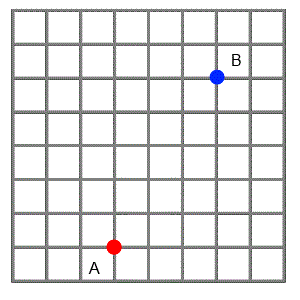Skip over navigation
The grid below represents a city laid out in "blocks" with all the roads running north-south, or east-west.
Imagine two friends live where the red and blue dots are on the grid.

The animation shows three paths that one friend could choose if he wanted to visit the other. He likes to find the shortest routes possible, so he always travels north or east, never south or west.
What interesting mathematical questions could you explore on a city grid like this one?
Click below for some ideas.
How many different paths are there from A to B?
If I know the coordinates of two points, can I quickly work out how far I will have to walk to get from one to the other?
Is there a quick way to find all the different paths from one point to another?
Is there a quick way to work out how many different paths there will be?
If I start at a point and only want to walk 6 blocks, how many possible places might I end up?


Or search by topic
Number and algebra
Geometry and measure
Probability and statistics
Working mathematically
Advanced mathematics
For younger learners
Getting Round the City
Age 11 to 16
This resource is part of "Dotty Grids - Exploring Distance"
The grid below represents a city laid out in "blocks" with all the roads running north-south, or east-west.
Imagine two friends live where the red and blue dots are on the grid.

The animation shows three paths that one friend could choose if he wanted to visit the other. He likes to find the shortest routes possible, so he always travels north or east, never south or west.
What interesting mathematical questions could you explore on a city grid like this one?
Click below for some ideas.
How many different paths are there from A to B?
If I know the coordinates of two points, can I quickly work out how far I will have to walk to get from one to the other?
Is there a quick way to find all the different paths from one point to another?
Is there a quick way to work out how many different paths there will be?
If I start at a point and only want to walk 6 blocks, how many possible places might I end up?
You may also like
What's Possible?
Many numbers can be expressed as the difference of two perfect squares. What do you notice about the numbers you CANNOT make?
Why 24?
Take any prime number greater than 3 , square it and subtract one. Working on the building blocks will help you to explain what is special about your results.

